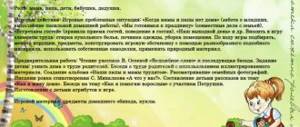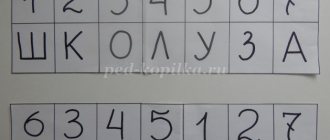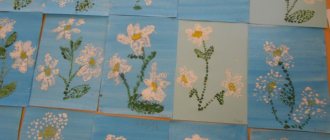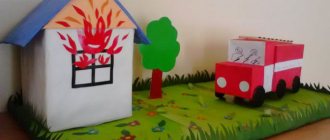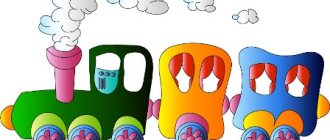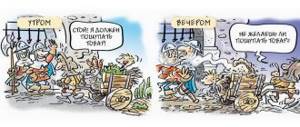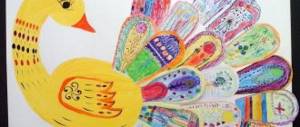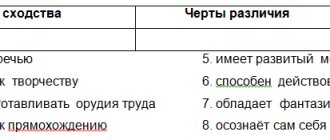Role-playing game for children “Theater”
“Theater is not fashion – it is forever!”
Role-playing game "Theater" in the preparatory group
Goal: To develop the ability to apply previously acquired knowledge about the surrounding life in the game. Strengthen children's understanding of the theater. Form positive relationships and a culture of behavior in public places. To develop children’s ability to perform a performance based on the familiar fairy tale “Turnip”, expressively convey in speech the images of the fairy tale’s heroes, and coordinate their actions with other “artists”. Improve the ability to create a game environment for a planned plot.
Tasks:
Educational field “Social and communicative development”:
- Development of children's play activities
- Establish rules of behavior in public places
- Develop the ability to listen to comrades, thank the “artists” with applause.
Educational field “Speech development”:
- Children's practical knowledge of speech norms
- Enrichment of vocabulary (poster, foyer, auditorium, scenery, stage, costume designer, puppeteer, director).
- Introduction to verbal art
Educational field “Artistic and aesthetic development”:
- Development of musical and artistic activities
- Production of tickets, posters
- Organization of the exhibition “Favorite Fairy Tale Hero”
PRELIMINARY WORK: conversations, visiting the theater, observations, reading a fairy tale, puppet show, joint production of attributes for the game.
GAME ROLES: cashier, buffet worker, controller, artists, spectators.
GAME MATERIAL: box office, theater tickets, poster, screen, large signs “Theatre”, “Auditory Hall”, “BUFFET”, “Flower Shop”, flowers in vases and baskets, display case in the cupboard, toy dishes, food models, furniture, bags, money, chairs, where the row and place are marked.
Progress of the game.
Educator: Children, today they handed me a mysterious envelope. (I read the address.) Let's see what's in this envelope. And in this envelope is a poster for the play.
I draw the children's attention to the poster.
- Look, they sent us a poster from the theater. After reading it, we will find out what kind of performance will take place in the theater, when and at what time.
I suggest the children read the poster.
— Guys, the play “Turnip” will take place today at 10 o’clock.
— Tell me, please, what is theater? (children's answers)
— What types of theaters do you know? (children's answers)
Educator: Today there are a great many varieties of theater to suit every taste. Drama theater is a classic one. Ballet, Opera, the works of which are staged in a small room for a not very large circle of people, are called chamber theater, Author's theater (also called non-traditional, experimental), animal theater (for example, Durovs, Kuklachev), shadow theater, for children - theater for young spectators , puppet theater, theater of miniatures, when the production itself is short in duration.
— We also have theaters in the city of Bryansk.
— What theaters are there in our city? (Children's answers)
Bryansk Regional Drama Theater named after. A.K. Tolstoy, Bryansk Regional Theater for Young Spectators, Bryansk Regional Puppet Theater, Children's Musical Theater "Orpheus"
- Who works in the theater? (children's answers)
— where do the artists perform? (children's answers) and if the theater is a puppet theater, who will be the actor then? (children's answers) But the dolls themselves cannot move, who controls them? (children's answers). Who directs the production of the play and distributes the roles? (children's answers)
- before we go to the theater, let's remember the rules of behavior in the theater.
1. You must come to the performance on time, you cannot be late
2. don’t make noise, don’t knock, don’t talk,
3. do not shout, do not bring food with you and eat during the performance, do not damage the furniture.
After the end of the performance, you should thank the artists for their performance with applause or give them flowers.
“It’s time for us to go to the theater immediately so as not to be late for the performance.”
Song "It's fun to walk together..."
Educator: Here we are. Come on in. Children, what is needed to get to the theater for a performance? (children's answers). Of course, get in line and buy a ticket at the box office. Let's choose who will be our cashier and controller who will check the tickets? (You can choose with a little count).
Go to the cashier.
Children buy tickets.
After purchasing a ticket, children enter the theater foyer. The controller checks the tickets.
- Children, we went into the foyer with you. Who can tell me what a foyer is? (children's answers)
Wardrobe. Children, please tell me what a wardrobe is for and what it is? (children's answers). Who works there? (children's answers).
- What do you think we can do with our free time before the performance starts? (children's answers).
I assign one of the children to the role of a buffet worker.
— How can you thank the artists after watching the performance? (children's answers).
Right. We have a flower kiosk.
The first bell rings. After the first bell, children enter the auditorium and take a seat according to the image on the ticket (geometric shapes of various colors and numbers)
Actors - children go behind the screen to show a fairy tale
The second bell rings. The audience applauds. After the third bell, the show begins.
After the performance, the audience applauds, the artists come out to bow.
- Guys, where were we today?
Summarizing:
Which theater?
What is the name of the fairy tale we watched?
What did you like most?
And I really liked the way you played, you handled your roles well, you were polite, behaved correctly in public places, and tried to expressively convey the images of the fairy tale characters in your speech. Next time you play this game, you will switch roles.
Summary of the role-playing game in the senior group “Trip to the Theater”
- Consolidating children's ideas about the theater, the theater troupe, and theater workers.
- Developing the ability to act out a performance based on a familiar fairy tale.
- Development of the ability to expressively convey in speech the images of fairy tale heroes, to coordinate one’s actions with other “artists.”
- Improving the ability to create a game environment for a planned plot.
- Developing the ability to take on a role and act in accordance with it until the end of the game.
- Forming positive relationships and a culture of behavior in public places, using polite words in speech.
PRELIMINARY WORK:
conversations, going to the theater, making posters.
GAME MATERIAL:
Screens, posters, tickets, costumes, elements of costumes, chairs, artificial flowers, bell, steering wheel, road sign “Bus stop” (2 pcs.), signs “Cash desk”, “Costume room”, “Getting room”, “Buffet”, toy dishes , models of products, furniture, bags, wallets, scenery for a performance, theater booklets, illustrations.
GAME ROLES:
Artists, spectators, theater ticket cashier, make-up artist, costume designer, prop maker, theater buffet worker, bus driver, conductor.
PROGRESS OF THE GAME
Educator: “Guys, we talked a lot about the theater. I talked about the professions of people who are in the theater. We went with you and your parents to the theater. And today I want to invite you to go to the theater again.”
“How can we get there?” Children: “On the bus” Children build a bus from chairs. Teacher: “Before we get on the bus, do we need to choose who?” Children: “The bus driver and conductor” Educator: “How will we do this?” Children: “A little counting rhyme will help us”
Children count, choose a driver and conductor, and take attributes for the game. Children passengers occupy seats at bus stops. On the bus, the children pay the conductor, receive tickets from him, and go to the Theater stop.
Educator: “Well, you and I have arrived at the theater. I wonder what performance is on at the theater today?”
The teacher draws the children's attention to the theater poster.
The children say that today there is a performance at the theater based on the fairy tale “The Fox and the Hare.”
Educator: “Guys, before we go into the theater, let’s assign roles.” The teacher distributes the roles that the children will play and discusses them with the children. Children go to their “workplaces”.
The actors, make-up artist, costume designer, prop maker go to prepare for the performance. The props maker sets up the stage.
A buffet worker is arranging items in the buffet. Spectators go to the box office, buy tickets and wait for the performance to start in the foyer, looking at magazines and booklets. When the third bell rings, the audience sits down in the hall, and they are joined by a make-up artist, a costume designer, a cashier, and a buffet worker. Children perform a performance. After watching the performance, the audience applauds the artists, shouts “Bravo!”, and gives flowers.
After the performance, the audience goes to the buffet, they are joined by artists and theater workers who have finished their work.
Educator: “Guys, the theater is closing soon, a bus is waiting for us to take us back to kindergarten.”
Children get on the bus and arrive at kindergarten.
For the full text of the material: Summary of the role-playing game in the senior group “Trip to the Theater”, see the downloadable file
. The page contains a fragment.
| Author: Sozykina Nelly Vladimirovna → Nelly0428 05/08/2013 2 14910 722 | Comment |
Thank you for your mark. If you want your name to be known to the author, log in to the site as a user and click Thank you again. Your name will appear on this page.
Login | Registration
Have an opinion? Leave a comment
Role-playing game "Theater" (preparatory group)
Plot-role-playing game “Theater” (preparatory group)
Purpose of the game:
- teach children to distribute roles and play them to the end;
- practice the ability to negotiate with each other;
- cultivate goodwill and form a positive relationship between children during play;
- develop social and communication skills;
- clarify and generalize children’s knowledge about theater and theatrical professions; develop dialogical speech;
- expressiveness of the role;
- imagination and creativity.
Preliminary work: conversations with children about the theater, about theater workers; looking at illustrations of our city’s theaters; reading works about the theater “The Magic World - Theater” by T. Grigoriev, “In the Theater” by A. Barto; a trip and viewing of a performance in a children's theater; games - dramatizations based on fairy tales; watching the cartoon “Zayushkina’s Hut”; conversation about what he saw.
Game attributes: signs: theater, ticket office, buffet, dressing room, costume room; attributes for the cafe game; paper and colored pencils; material for making flowers; paper wallets and coins; makeup; mobile phones (toy); bell.
Playing roles: actors, costume designer, make-up artist, graphic designer, barmaid, cashier, controller, taxi driver.
Progress of the game: in the morning an announcement appears “Attention, attention! Tonight the play “Zayushkina’s Hut” will take place. Director Tatyana Viktorovna is recruiting actors, costume designers, graphic designers, make-up artists, cafe workers, and cashiers. I conduct a discussion, observe the distribution of roles, if there are children who do not want to take part in the play, then I invite them to become spectators, but if everyone agrees to participate in the production, then we invite children from the junior and middle groups to become spectators. At the beginning of the conversation, I demonstrate and clarify the children’s knowledge about the theater and theatrical professions. Please note that before the audience sees the performance, many people are involved in its preparation. Educator: guys, do you know what theater is? and what is it for? Children: a theater is a place where various performances are shown for children and adults. Educator: do you know what kind of theaters there are? Children: children's musical theater, puppet theater, shadow theater, drama theater, Bolshoi Theater, animal theater. Educator: guys, what do you think theaters are for? Children: so that adults and children can go in their free time and watch interesting performances; they help people cheer up and get a lot of positive emotions; see and learn something new and interesting; meet the actors and see their skills. Educator: how many of you know what is in the theater? Children: auditorium, buffet, wardrobe, stage, backstage. Educator: now let's talk to you about each of the places you named. Let's start with the wardrobe, what is a wardrobe and what is it for? (children's answers) That's right, guys, this is the place where the viewer first of all goes, there is also a saying “The theater begins in the hangers.” Educator: let's go further and come to the buffet, what is it for? (children's answers) It is really necessary so that people can have a snack or eat something tasty, because sometimes it happens that some spectators visit the theater after the end of the working day. Educator: now we have reached the auditorium, what interesting things can we see there? (children's answers) Indeed, the auditorium is one of the most interesting places in the theater, because it is there that the artist, being on stage, seems to be communicating with the viewer, conveying the character of the hero with his intonation, facial expressions, and gestures. Educator: So we are left with one of the most mysterious places in the theater, what do you think? (children's answers) That's right, these are the backstage, these are the rooms that help a person transform into the necessary character. Educator: Do you know what professions people work in the theater? (children's answers) What do the actors do before the performance? (children's answers) distribute roles, rehearse. What do costume designers do, what is the name of the room they work in? (children's answers) select appropriate costumes for the roles, masks, wigs and all the necessary attributes, sew the costumes and iron them. What do make-up artists do? (children's answers) with the help of makeup and small additions they help the artist become more similar to his character. What do graphic designers do? (children's answers) prepare the scenery, draw sketches of tickets. What do cafe workers do? (children's answers) they decorate the window, buy goods - products. Do spectators need to prepare for visiting the theatre? (children's answers) buy a ticket; prepare an outfit; buy flowers to present to the artists.
Then the children begin to act in accordance with the chosen role, I move from one group to another.
1. Cafe - I’ll ask what products are sold in the cafe, what the goods will be laid out on, how buyers will find out the price, where the seller will put the money received for the purchase.
2 Artists - I’ll ask how to design 2 screens - houses, so that you can see where whose house is (fabrics), what decorations can be added to make it more similar to the forest (trees), I’ll suggest creating a sketch of tickets (competition), if there are heroes who need attributes, I’ll find out from the guys what will they make them from?
3 Costume and make-up artists - I get involved if necessary.
4 Rehearsal - what is the hare’s mood at the beginning of the fairy tale, how to show this in his voice? As the fox says, does the intonation of the fox’s voice change at the beginning of the fairy tale and then? What words do everyone say when they meet a hare? Are the voices of a dog, a bear and a rooster different?
In the morning, the first part of the game takes place (rehearsal of a fairy tale, selection of costumes, selecting a sketch of a ticket (multiplying it) - competition, decoration of houses, decoration of a cafe)
In the evening: while the performers are putting on their costumes, they are assisted by costume designers; artists design the stage; the usher sells tickets; spectators buy tickets and choose attributes of festive clothing, call a taxi and head to the theater; ticket collectors check tickets, explain where to go and offer to purchase a program (made from sketches that did not pass the competition), invite you to a cafe, warning that entry into the auditorium after the third bell is prohibited. Then spectators from other groups watch the performance, at the end they applaud and give flowers. During the game, I pay attention to how the dialogues are constructed (expanded, polite forms, the ability to listen to the partner’s speech to the end). If there are unused children, additional roles are selected: a taxi driver, a television cameraman or a correspondent who interviews artists.
At the end of the game, I will summarize: did you like the role you chose? Do you think you managed to convey the character of your character? What role would you like to play next time? I really liked the performance, all the characters were very bright and memorable. Each character knew his words and acted in accordance with the text. The audience was very polite and well-mannered, they did not speak during the performance, they said magic words at the buffet (hello, thank you, please, goodbye). All theater workers performed their duties with dignity. I would like to come to your theater again. Thanks everyone!
Teacher of the first qualification category Tatyana Viktorovna Kozubnyak
Summary of the role-playing game "Theater" in the senior group.
Municipal budgetary educational preschool institution kindergarten "Zvezdochka" village. Milovka, Ufa district
Republic of Bashkortostan
Zulkarneeva Gulfira Minivaleevna
Educator
Summary of the role-playing game "Theater" in the senior group
.
Target
. To develop the ability to apply previously acquired knowledge about the surrounding life in the game. Strengthen children's understanding of the theater. Form positive relationships and a culture of behavior in public places. To develop children’s ability to act out a performance based on the familiar fairy tale “The FOX, THE HARE AND THE COCK.” Continue to develop the ability to expressively convey the images of fairy tale characters in speech, and coordinate your actions with other “artists.” Improve the ability to create a game environment for a planned plot.
Vocabulary work
: poster, foyer, auditorium, scenery, stage, intermission, make-up artist, costume designer.
Preparing for the game
: conversations, visiting the theater, observations, reading a fairy tale, puppet show, joint production of attributes for the game.
Game roles
: bus driver, conductor, cashier, seller in a flower shop, cafe worker, make-up artist, costume designer, controller, actors, spectators, cloakroom attendant.
Game material
: steering wheel, travel tickets, bag for the conductor, road signs “Bus stop” and “pedestrian crossing”, box office, theater tickets, poster, invitation cards, print, program, screen, large signs “Theater”, “Cafe”, “Shop” flowers”, flowers in vases and baskets, a display case in a cafe, toy dishes, models of products, furniture, signs with the inscriptions “Closed”, “Menu”, “Costume room”, “Getting room”, “Wardrobe”, bags, wallets, money, chairs, where the row and place are marked.
Progress of the game
.
Educator
: Children, I was given a mysterious envelope today. (I read the address.) Let's see what's in this envelope. And in this envelope is an invitation ticket to the performance.
I draw the children's attention to the poster.
—
Look, the theater sent us not only an invitation card, but also a poster.
After reading it, we will find out what kind of performance will take place in the theater, when and at what time.
I suggest the children read the poster.
— Guys, the play “The FOX, THE HARE AND THE COCK” will take place today at 10 o’clock. We need to go to the theater immediately so as not to be late for the performance.
—
How can we get there?
(By bus).
The bus is already waiting for us.
I assign one of the children to the role of driver and conductor.
— What do you need to buy to see the performance? (Theater tickets). Today Vilena will be the cashier.
— Why is there a wardrobe in the theater? Who wants to be a cloakroom attendant?
- What do you think we can do with our free time before the performance starts? (Go to a cafe, drink tea, coffee, juice, eat ice cream, cake, etc., sit in the lobby, read a program, magazines).
I assign one of the children to the role of a cafe worker.
— How can you thank the artists after watching the performance? ( Applause, shout “Bravo!”, give flowers).
I nominate one of the children to play the role of flower seller.
— Our theater artists today will be Ksenia, Arthur, Ilya, Dima, Yaroslav, Misha.
— Why do you need a make-up artist and costume designer? Who wants to fill their roles?
“And the rest of the children will play the role of visitors to a cafe, a flower shop, or theater spectators.”
And now it's time for us to go to the theater. Driver and conductor, take your seats on the bus, and we are going to the bus stop. I draw your attention to the fact that children cross the road correctly at the pedestrian crossing.
We enter the bus through the back door. On the bus, children pay the conductor, receive tickets from him and go to the Theater stop. When leaving the bus, travel tickets are thrown into the trash bin.
After walking through the theater, I advise the children to begin playing their roles. The wardrobe attendant takes the clothes. The seller goes to the flower shop. Cashier - to the cash register. A cafe worker serves visitors. The theater performers head to the costume and dressing rooms. Spectators buy theater tickets, flowers, go to cafes, sit in the lobby, read magazines. The bus driver and conductor join them.
After the second bell, the audience begins to take seats in the hall in accordance with the theater tickets, where the row and seat are indicated. The ticket controller checks the tickets. They are joined by a flower seller, a cafe worker, a cashier, a costume designer and a make-up artist. They also bought their own tickets.
I closely monitor the game and, if necessary, provide advice or my participation in helping in a given situation.
After the third bell the performance begins. Children - "artists" perform the play "FOX, HARE AND ROOSTER". After watching the performance, children clap, shout “Bravo!”, and give flowers to the “artists” when they come out to bow.
- Guys, today I really liked the way you played, you coped well with your roles, you were polite, behaved correctly in public places, and tried to expressively convey the images of the fairy tale characters in your speech. Next time you play this game, you will switch roles. And now we go to the bus stop and go back to kindergarten.
